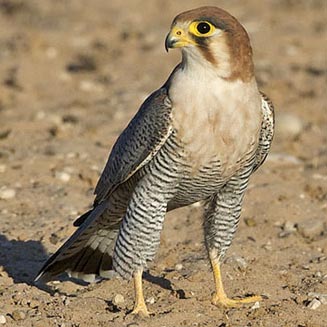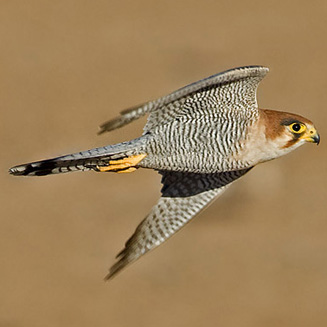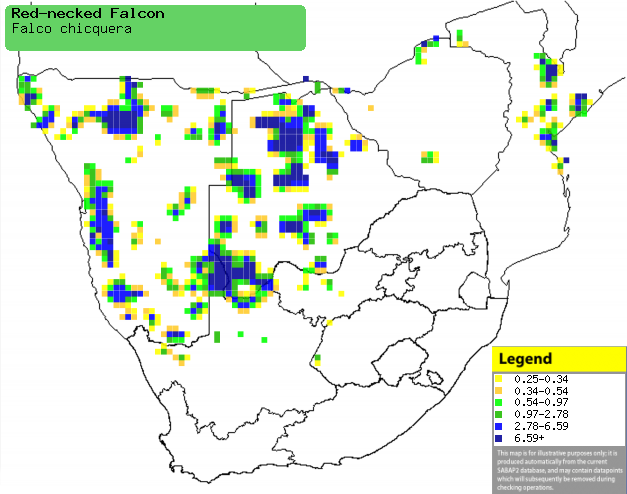|
Falco chicquera (Red-necked
falcon)
Rooinekvalk [Afrikaans]; Kakodi (generic term for
sparrowhawks, goshawks, kestrels and falcons) [Kwangali]; Rukodzi (generic name
for a small raptor such as falcon or sparrowhawk) [Shona]; Rigamani, Rikhozi
(generic terms for some falcons) [Tsonga]; Roodkopsmelleken [Dutch]; Faucon
chicquera [French]; Rothalsfalke [German]; Falc„o-de-nuca-vermelha [Portuguese]
Life
> Eukaryotes >
Opisthokonta
> Metazoa (animals) >
Bilateria >
Deuterostomia > Chordata >
Craniata > Vertebrata (vertebrates) > Gnathostomata (jawed
vertebrates) > Teleostomi (teleost fish) > Osteichthyes (bony fish) > Class:
Sarcopterygii (lobe-finned
fish) > Stegocephalia (terrestrial
vertebrates) > Tetrapoda
(four-legged vertebrates) > Reptiliomorpha > Amniota >
Reptilia (reptiles) >
Romeriida > Diapsida > Archosauromorpha > Archosauria >
Dinosauria
(dinosaurs) > Saurischia > Theropoda (bipedal predatory dinosaurs) >
Coelurosauria > Maniraptora > Aves
(birds) > Order: Falconiformes >
Family: Falconidae
 |
 |
|
Red-necked falcon, Kgalagadi National Park, South
Africa. [photo Johann
Grobbelaar ©] |
Distribution and habitat
It has isolated populations in both India and sub-Saharan
Africa, absent from much of the DRC and West Africa. In southern Africa it is
generally uncommon in patches of Namibia, Botswana, northern Zimbabwe,
north-west South Africa and central Mozambique. It generally prefers open savanna
woodland, but it also occurs in Hyphaene palm savanna.
|
 |
|
Distribution of Red-necked falcon in southern
Africa, based on statistical smoothing of the records from first SA Bird
Atlas Project (©
Animal Demography unit, University of
Cape Town; smoothing by Birgit Erni and Francesca Little). Colours range
from dark blue (most common) through to yellow (least common).
See here for the latest distribution
from the SABAP2. |
Movements and migrations
Generally resident and sedentary, as pairs
usually remain in their territories year-round. It is
sometimes nomadic so that it can exploit temporarily abundant food
sources.
Food
It mainly eats small to medium-sized birds, supplemented
with small mammals and insects, taken either aerially or from the ground.
It often hunts in pairs; the larger female flushes a bird which the male then
takes down aerially. The Gabar goshawk may also take the role of the female,
flushing prey so that the Red-necked falcon can catch it, after which they both
feed on the carcass; a unique partnership among falcons. It is even agile and fast enough to
hunt swallows aerially in dramatic chases, and may also ambush prey from a
concealed position in the tree canopy. The following food items have been recorded
in its diet:
- Animals
- birds
- small mammals
- insects
Breeding
- Monogamous, territorial solitary nester, with a long pair bond.
- It usually uses the stick nest of a crow
or large raptor, placed at the top
of a tree or at the base of a Borassus or Hyphaene palm
frond, sometimes displacing the active breeding pair who built the nest.
- Egg-laying season is from July-October, peaking from August-September.
- It lays 2-4 eggs which are incubated solely by the female for about
32-34 days, while the male delivers food to her at the nest.
- The chicks are brooded constantly by the female until they are 5-6 days
old, at which point the female starts to help the male hunt for food. They
eventually leave the nest at 34-37 days old, probably becoming fully
independent 1-3 months later.
Threats
Not threatened, in fact it is well-represented in protected
areas and has benefited from artificial water bodies in arid areas.
References
-
Hockey PAR, Dean WRJ and Ryan PG 2005. Roberts
- Birds of southern Africa, VIIth ed. The Trustees of the John Voelcker
Bird Book Fund, Cape Town.
|
